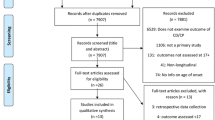Abstract
Several recent studies have found an association between conduct problems and bipolar disorder in adolescents. However, prospective studies are rare and most do not apply multivariable analysis strategies to control for important variables (e.g. socio-demographics). The aim of this study was to test the association between certain conduct problems and bipolar disorders. The sample consisted of 591 adolescents (male and female) representative for 2,600 persons from the Canton of Zurich in Switzerland. Data were prospectively collected through an interviewing procedure, with the first screening taking place at the age of 19–20. The incidence rate was computed using sampling weights, and risk factors of bipolar II disorder were estimated using a multivariable logistic regression model. The 9-year incidence rate of bipolar II disorder in the canton of Zurich was 8.4% (n = 65). Adolescents and children showing behavior such as repeated running away from home and physical fighting were 2.6–3.5 times more likely to experience a bipolar II disorder than those with no indication of conduct problems. Sensitivity analysis showed that the conduct problems were not the result of low socio-economic status.
Similar content being viewed by others
References
Akiskal HS (1998) The childhood roots of bipolar disorder. J Affect Disord 51:75–76
Angst J, Gamma A, Benazzi F, Ajdacic V, Eich D, Rossler W (2003) Toward a re-definition of subthreshold bipolarity: epidemiology and proposed criteria for bipolar-II, minor bipolar disorders and hypomania. J Affect Disord 73:133–146
Biederman J, Mick E, Wozniak J, Monuteaux MC, Galdo M, Faraone SV (2003) Can a subtype of conduct disorder linked to bipolar disorder be identified? Integration of findings from the Massachusetts General Hospital Pediatric Psychopharmacology Research Program. Soc Biol Psychiatry 53:952–960
Biedermann J, Faraone SV, Hatch M, Mennin D, Taylor A, George P (1997) Conduct disorder with and without mania in a referred sample of ADHD children. J Affect Disord 44:177–188
Carlson GA (1999) Developmental aspects of comorbidity in mania. In: Tohen M (ed) Comorbidity in affective disorders. Marcel Dekker, Inc., New York, pp 263–280
Carlson GA, Weintraub S (1993) Childhood behavior problems and bipolar disorder—relationship or coincidence? J Affect Disord 28:143–153
Chang KD, Steiner H, Ketter TA (2000) Psychiatric phenomenology of child and adolescent bipolar offspring. J Am Acad Child Adolesc Psychiatry 39:453–460
DelBello MP, Geller B (2001) Review of studies of child and adolescent offspring of bipolar parents. Bipolar Disord 3:325–334
Derogatis R (1977) Symptom checklist 90 (SCL-90). John Hopkins University Press, Baltimore, MD
Dilsaver SC (2001) Unsuspected depressive mania in pre-pubertal hispanic children reffered for the treatment of depression with history of social deviance. J Affect Disord 67:187–192
Egeland JA, Shaw JA, Endicott J, Pauls DL, Allen CR, Hostetter AM (2003) Prospective study of prodromal features for bipolarity in well Amish children. J Am Acad Child Adolesc Psychiatry 42:786–796
Hays JC, Krishnan RR, George LK, Blazer DG (1998) Age of first onset of bipolar disorder: demographic, family history, and psychosocial correlates. Depression and Anxiety 7(2):76–82
Hosmer DW, Lemenshow S (2000) Applied logistic regression. John Wiley & Sons, Inc., New York
Kessing LV, Andersen PK, Mortensen PB (1998) Predictors of recurrence in affective disorder. A case register study. J Affect Disord 49:101–108
Kovacs M, Pollock M (1995) Bipolar disorder and comorbid conduct disorder in childhood and adolescence. J Am Acad Child Adolesc Psychiatry 34:715–723
Kutcher SP, Marton P, Korenblum M (1989) Relationship between psychiatric illness and conduct disorder in adolescents. Can J Psychiatry 42:623–631
Lapalme M, Hodgins S, LaRoche C (1997) Children of parents with bipolar disorder: a metaanalysis of risk for mental disorders. Can J Psychiatry 42:623–631
Laroche C, Cheifetz PN, Lester EP (1981) Antecedents of bipolar affective disorders in children. Am J Psychiatry 138:986–988
Lewinsohn PM, Klein DN, Seeley JR (2000) Bipolar disorder during adolescence and young adulthood in a community sample. Bipolar Disord 2:281–293
Lewinsohn PM, Klein DN, Seeley JR (1995) Bipolar disorders in a community sample of older adolescents: prevalence, phenomenology, comorbidity, and course. J Am Acad Child Adolesc Psychiatry 34:454–463
MacQueen GM, Young LT (2001) Bipolar II disorder: symptoms, course, and response to treatment. Psychiatr Serv 52:358–361
Pine DS, Cohen P, Johnson JG, Brook JS (2002) Adolescent life events as predictors of adult depression. J Affect Disord 68:49–57
Radke-Yarrow M, Nottelmann E, Martinez P, Fox MB, Belmont B (1992) Young children of affectively ill parents: a longitudinal study of psychosocial development. J Am Acad Child Adolesc Psychiatry 31:68–77
Reichart CG (2005) Being a child of a bipolar parent. Psychopathology, social functioning and family functioning. Erasmus Universiteit, Rotterdam
Robins LN, Price RK (1991) Adult disorders predicted by childhood conduct problems: results from the NIMH Epidemiologic Catchment Area project. Psychiatry 54:116–132
Wicki W, Angst J (1991) The Zurich Study. X. Hypomania in a 28- to 30-year-old cohort. Eur Arch Psychiatry Clin Neurosci 240:339–348
Wozniak J, Biederman J, Faraone SV, Blier H, Monuteaux MC (2001) Heterogeneity of childhood conduct disorder: further evidence of a subtype of conduct disorder linked to bipolar disorder. J Affect Disord 64:121–131
Wozniak J, Biederman J, Mundy E, Mennin D, Faraone SV (1995) A pilot family study of childhood-onset mania. J Am Acad Child Adolesc Psychiatry 34:1577–1583
Acknowledgements
This work was supported by Grant 3200-050881.97/1 of the Swiss National Science Foundation.
Author information
Authors and Affiliations
Corresponding author
Rights and permissions
About this article
Cite this article
Endrass, J., Vetter, S., Gamma, A. et al. Are behavioral problems in childhood and adolescence associated with bipolar disorder in early adulthood?. Eur Arch Psychiatry Clin Neurosci 257, 217–221 (2007). https://doi.org/10.1007/s00406-006-0710-2
Received:
Accepted:
Published:
Issue Date:
DOI: https://doi.org/10.1007/s00406-006-0710-2




